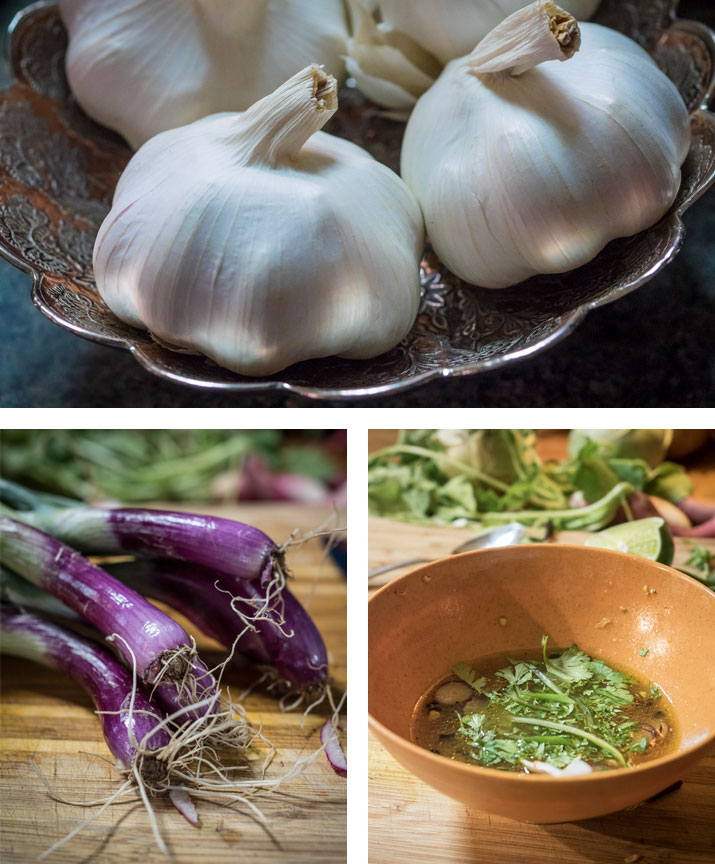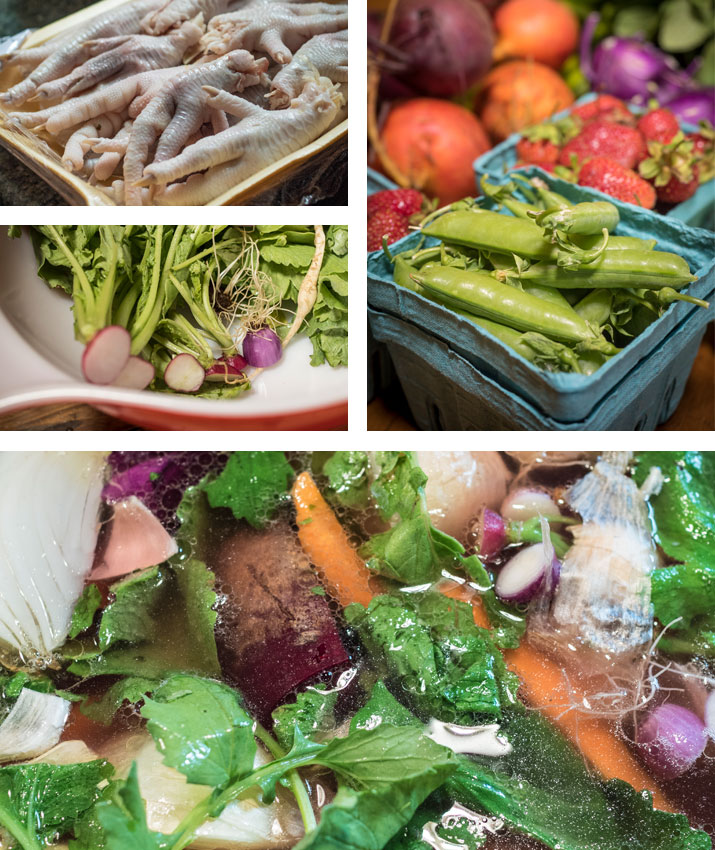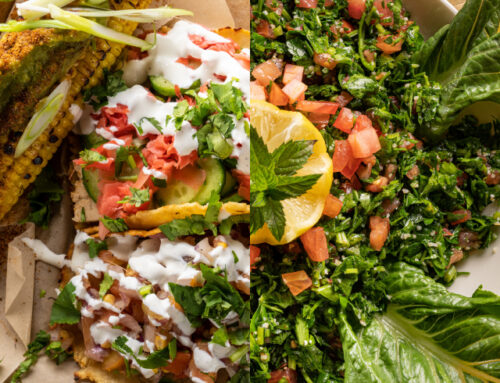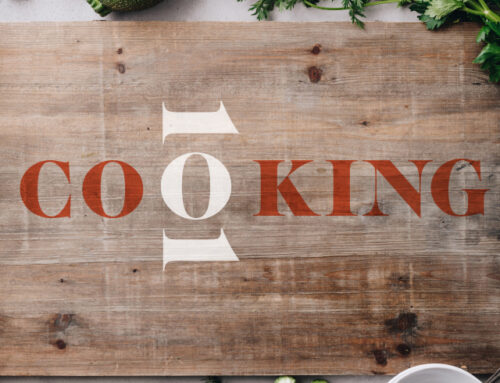The More-Taste, Less-Waste Kitchen
by Lenora Dannelke



In this season of abundance, farm stands – and home gardens like that of photographer Ryan Hulvat – are bursting with fabulous fresh foods. With a few simple adjustments in your cooking habits, home cooks can capture the full benefits of this bounty.
For example, items often relegated to the compost heap include those hairy ends of scallions, plus radish and beet greens, all of which can add flavor and nutrients to a pot of stock. Or give the greens a chance to please your palate in stir-fries and pasta tosses, or replace basil with either of them the next time you make pesto. (If the price of pine nuts puts you off from making this taste-of-summer treat, substitute cashews, walnuts, pistachios, or roasted sunflower seeds.)
A stockpot is a fundamental tool in avoiding food waste. Throwing bones, spices, and assorted veggies – especially odd bits like celery leaves, sweet potato peels, and carrot and zucchini ends – into water, bringing to a boil and simmering for hours before straining (and discarding solids) will result in a rich-tasting and nutritious liquid that can be used in soups, chili, stews and sauces, or add flavor when cooking rice, grains or couscous.
Documenting a recent stock-making session, Hulvat began by lightly browning beef marrow bones and chicken feet in a large pot. (There is an “ick” factor to chicken feet, which some stores are now labeling “chicken paws” to make them sound less off-putting. However, they’re worth using due to the extremely high level of collagen they contain, which has been claimed to improve skin, help to slow arthritis, improve the blood, aid digestive and intestinal problems and more. From personal experience, chicken foot broth improved colitis far better than anything my gastroenterologist suggested. Bone broth is currently a hot topic and there are multiple books on the subject on the market.)
Hulvat next added water, filling the pot half-way, and veggies: radish greens, a sliced sweet potato, a handful of scallion ends, a chopped carrot with roots and greens, and a corn cob with kernel removed and reserved for later use. Spices were stirred in – red Sichuan peppercorns, fresh grated turmeric, mustard seeds, whole cloves and cumin – a bit more water added, and the pot was brought to a boil. Finally, he covered the pot, reduced the heat to a simmer and allowed the magic to happen over the next four to six hours.
Later he used part of the stock to make corn chowder with roasted corn and tomatoes. Tomorrow might bring a sausage soup with noodles or dumpling. And, no, he doesn’t use recipes. Instead, Hulvat is guided by experience. “I took a cooking class in Italy twenty-three years ago. We made simple Tuscan foods like chicken soup and bread soup,” he says. A life-long desire to explore food was sparked by the experience. “When I’m eating at a restaurant, especially at a photo shoot, I’m always watching or questioning. I like to eat and I want to know about the food I’m eating.”
Hulvat also considers soup to be an excellent template for experimentation, making a perfect dish for beginning cooks. “If you make a roast, it might be over- or underdone,” he says. “Soup is just putting together tastes that you like. How can you screw that up?” It’s the freestyle sport of the cooking world, so have fun with it!
Use It – Don’t Lose It!
Here are a few ways to get every last bit of flavor from favorite summer crops:
- Save kernel-less corn cobs in the freezer until you accumulate a dozen or so, then make a simple corn cob stock. The delicate flavor makes a lovely soup or outstanding risotto. Or: Try making old-timey corn cob jelly. It’s simple to prepare, has a beautiful golden color and a honey-like taste.
- If you’re canning tomatoes or making tomato sauce, the removed skins can be placed on a parchment-lined tray, patted flat and dried in a 200°F oven for about 4 hours. When cooled, grind into tomato powder and sprinkle on pretty much anything. Or: Just throw the raw skins in the freezer and add to your next batch of stock.
- Tomato water that remains on the cutting board after slicing ripe tomatoes has marvelous flavor and multiple uses, from creating refreshingly light bloody Marys to poaching fish, and much more. Pour the tomato water from the board through a strainer into a freezer container. Repeat this procedure each time you cut tomatoes, layering the tomato water until you have a pint or whatever amount you desire. It’s slow but worthwhile! To speed up the process, place chopped tomatoes in a cheesecloth-lined colander and set in a bowl. Cover and chill overnight to drain.
Amy Wardle, food stylist and principal of Astir Food, has a knack for creating amazing new uses for throwaway items:
Parmesan rinds
Add to stock or red sauce for extra cheesy umami flavor (just remember to fish them out before you serve); or, make cheese broth to use in an extra flavorful, silky, cheese risotto.
Chicken skin
This is my new addiction; flatten out and sandwich between baking sheets; bake at about 350°F until super crispy; chop and sprinkle over salmon tartare, salads, and other dishes. (It’s kind of like deploying “chicken” bacon bits.) Or break into large chips – yes, it gets that crispy – and use to scoop up a lovely, fresh cilantro-lime-peanut-jalapeno chopped mix.
Bacon fat
Use in scones, biscuits, cookies; blend into bacon butter and slather on spicy radishes or warm baked goods; cook eggs in it; use it in vinaigrette. C’mon, what isn’t better with bacon fat?
Leftover hard sausage
You know those ends of salami or other dried sausages that get too hard to eat? Throw them in a grinder and grind them all up together; use the resulting ground meat to stuff tortellini or ravioli.
Eggshells
Grind ’em up in your food processor or just crush with your hands and add them to your tomato plants. Mix the crushed shells into the soil and/or add a small handful to the planting hole. Tomatoes love calcium, so the shells make for healthier, stronger plants with tastier, more prolific fruit.
Leftover beef roast or steak
Slice thin and turn into stroganoff.
Lobster and/or shrimp shells
Add leeks, shallots, fennel, carrot, clam juice, water, etc., and simmer to make luscious shellfish stock for bisques and risottos.
Chinese takeout rice
Use that last box in the fridge to make fried rice, arancini or rice pudding.
Beef marrow bones
Don’t let your butcher smoke these for the dogs! Instead, bring them home raw, roast in the oven, serve with toasts and simple parsley salad. Scoop out the roasted marrow, spread on toast, add a bite of salad, pinch of sea salt.
As seen in the Summer/Fall 2016 Issue
Click to Visit Our Advertisers




